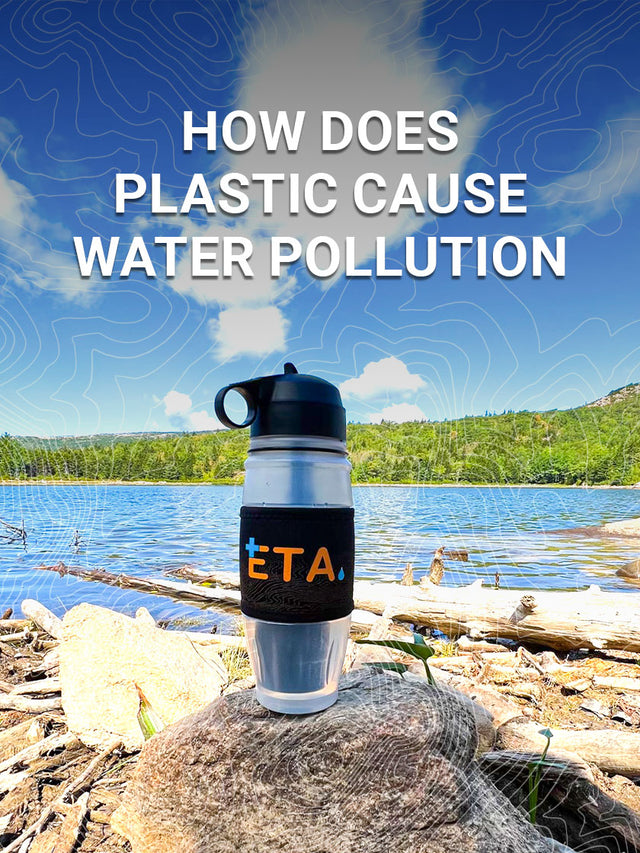
How Does Plastic Cause Water Pollution
Ever since plastic was equated to convenience and affordability, humans have become used to the practice of using plastics, especially single-use plastic products, in daily lives. However, the repercussions of using plastic and the long-term effects on our environment have been put on the back burner until recent times where various conscious individuals, brands, and organizations have raised their concerns and their voices to switch to more sustainable alternatives. This is because plastic pollutes the planet once it enters the environment as waste so much so that it outlives humans!

One of the more dire effects of plastic waste is water pollution. Our water resources and water quality are at risk from plastic, which takes decades or even hundreds of years to degenerate. It continues to contaminate the water bodies it is thrown in. These plastic products present in water for years pose a risk to not just marine life but also human life causing safe water sources to deplete. Single-use water bottles, coffee cups made of polystyrene, supermarket bags, synthetic clothing fiber, and other debris all contribute to plastic pollution. Now is the time to think about how plastic can cause water pollution and take the necessary action to prevent it.
What is Water Pollution?
When poisonous compounds enter water bodies like lakes, rivers, seas, and so forth, they can dissolve in the water, float on top of it, or settle on the bottom, causing pollution. This phenomenon affects the water's quality as well as the living beings who consume that water.
The contaminants not only seep through and reach the groundwater, which may then end up in our homes as tainted water we use for our daily activities, including drinking, but also signal doom for aquatic ecosystems.
How does plastic cause water pollution?
Plastic pollution is the buildup of plastic products and particles in the environment that harms people, wildlife, and their habitat. Examples include plastic bottles, bags, and microbeads. Plastic waste is divided into micro and macro rubbish depending on its size. Plastics are often preferred by manufacturers over other materials because they are affordable, strong, and well-suited for a wide range of applications.

However, because of their chemical composition, most plastics are sluggish to decay since they are resistant to a variety of natural processes. These two mechanisms work in tandem to allow significant amounts of plastic to enter the environment as improperly disposed of garbage and to persist in the ecosystem. With increased pilling of plastic waste, other natural sources including water and soil, are polluted, harmed, and endangered.
What will this lead to?
In water bodies all across the world, including our streams, rivers, lakes, and seas, microplastics have been found. The microplastics found in these streams end up in the water we drink and the fish, including shellfish, that we eat. Because of the use-and-throw culture, used plastic bags clog storm drains and culverts, preventing water from flowing freely and accelerating bank erosion.
Additionally, when plastic comes in physical contact with marine life, it affects their survival. Many times it gets entangled in their leg, neck, or other body parts, ultimately threatening their life. Animals frequently confuse plastic for food. Once consumed, the plastic is indigestible and causes damage to the animal by getting stuck in the intestines. Animals can suffocate in plastic bags as well.
Also, when plastics break down in water, hazardous substances contaminate it, damaging both human and animal health. The contaminants and the chemicals present in plastics damage the body's systems and can even lead to cancer.
Therefore, improving the condition of our water resources critically depends on reducing or avoiding single-use plastic items like water bottles, and plastic bags by acting responsibly and making wiser choices that eliminate plastic from our consumption patterns replacing it with more sustainable alternatives.

What makes ETA a sustainable solution?
The ETA Alkaline Water Filter Bottle uses the most recent Ionic Adsorption Micro Filtration (IAMF) Technology, which instantly starts the filtration process with a straightforward but distinctive sip and squeezes mechanism. It functions as a purification tool and a system that eliminates aesthetic, chemical, dissolved solids, and radiological contaminants from your everyday drinking water, regardless of the source.
With the help of ETA's Extreme Filtration technology, pollutants can be removed while the water's nutrients and minerals are preserved and turned into alkaline water with a pH of 9.5 that lasts for up to 30 days.
One of the most problematic and important components, contamination-free water, will undoubtedly be made easier by ETA. By filtering out any contaminants in the water and turning it into pure, safe-to-drink water, this portable water filter bottle makes it much easier to remain hydrated while also ensuring that the water you're consuming is safe even in an area where contamination is suspected.
How can ETA aid in avoiding water pollution through plastic waste?
One of the major impacts of ETA bottles is to avoid and reduce pollution in nature. Many individuals who are conscious about their health, believe in the power of hydration. Since they are afraid to drink water from public sources due to the impurities present in it, they end up buying bottled water or sparkling water from markets just to make sure that they are safe.

Yet, they are missing something. Even though they are largely safe from not consuming contaminated water, due to the heavy bulk of single-use plastic water bottles, they are ultimately adding to the pollution that harms nature. As these bottles won’t decay, their usage is going to continue to pile up tons of plastics. This is the very root cause of plastic entering water bodies and a vicious cycle on its own.
This is where ETA comes into action. The ETA Alkaline Water Filter Bottle is not your average water bottle. It carries water while filtering out contaminants and also saving the environment. With its Extreme Filtration capacity, you can make sure you never get the taste of nasty contaminants in your water.
At the same time, the ETA bottle is the perfect example of the 3R concept of “Reduce, Reuse, and Recycle”. ETA bottles are made using BPA-free plastic that doesn’t leech. It is also a reusable bottle that you can continue to refill and reuse indefinitely. The ETA filters are also replaceable which means by simply replacing the filter you can increase the lifetime of the bottle. This helps to reduce the usage of single-use plastics and as an effect, eliminate the amount of plastic waste produced. In addition, both the bottle and the filter are recyclable.
Therefore, we can say that the best course of action is to decrease the usage of single-use plastic water bottles, bags, straws, cups, and other things while bringing reusable items as alternatives into daily use. Switching from disposable to reusable drinking bottles like the ETA Alkaline Water Filter Bottle, you’re not just saving yourself but also saving working towards bettering the planet we live on, creating an environment that all living beings can enjoy equally.
